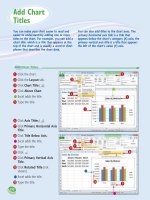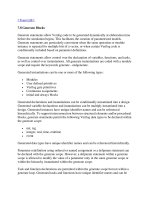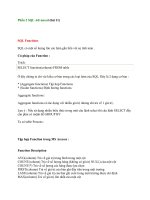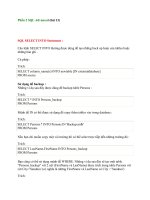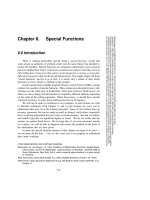Tài liệu Random Numbers part 1 ppt
Bạn đang xem bản rút gọn của tài liệu. Xem và tải ngay bản đầy đủ của tài liệu tại đây (34.44 KB, 2 trang )
Sample page from NUMERICAL RECIPES IN C: THE ART OF SCIENTIFIC COMPUTING (ISBN 0-521-43108-5)
Copyright (C) 1988-1992 by Cambridge University Press.Programs Copyright (C) 1988-1992 by Numerical Recipes Software.
Permission is granted for internet users to make one paper copy for their own personal use. Further reproduction, or any copying of machine-
readable files (including this one) to any servercomputer, is strictly prohibited. To order Numerical Recipes books,diskettes, or CDROMs
visit website or call 1-800-872-7423 (North America only),or send email to (outside North America).
Chapter 7. Random Numbers
7.0 Introduction
It may seem perverse to use a computer, that most precise and deterministic of
all machines conceived by the human mind, to produce “random” numbers. More
than perverse, it may seem to be a conceptual impossibility. Any program, after all,
will produce output that is entirely predictable, hence not truly “random.”
Nevertheless, practical computer “random number generators” are in common
use. We will leave it to philosophers of the computer age to resolve the paradox in
a deep way (see, e.g., Knuth
[1]
§3.5 for discussion and references). One sometimes
hears computer-generated sequences termed pseudo-random,while the word random
is reserved for the outputof an intrinsicallyrandom physical process, like the elapsed
time between clicks of a Geiger counter placed next to a sample of some radioactive
element. We will not try to make such fine distinctions.
A working, though imprecise, definition of randomness in the context of
computer-generated sequences, is to say that the deterministic program that produces
a random sequence should be different from, and — in all measurable respects —
statistically uncorrelated with, the computer program that uses its output. In other
words, any two different random number generators ought to produce statistically
the same results when coupled to yourparticular applications program. If they don’t,
then at least one of them is not (from your point of view) a good generator.
The above definition may seem circular, comparing, as it does, one generator to
another. However, there exists a body of random number generators which mutually
do satisfy the definition over a very, very broad class of applications programs.
And it is also found empirically that statistically identical results are obtained from
random numbers produced by physical processes. So, because such generators are
known to exist, we can leave to the philosophers the problem of defining them.
A pragmatic point of view, then, is that randomness is in theeye of the beholder
(or programmer). What is random enough for one application may not be random
enough for another. Still, one is not entirely adrift in a sea of incommensurable
applications programs: There is a certain list of statistical tests, some sensible and
some merely enshrined by history, which on the whole will do a very good job
of ferreting out any correlations that are likely to be detected by an applications
program (in this case, yours). Good random number generators ought to pass all of
these tests; or at least the user had better be aware of any that they fail, so that he or
she will be able to judge whether they are relevant to the case at hand.
274
7.1 Uniform Deviates
275
Sample page from NUMERICAL RECIPES IN C: THE ART OF SCIENTIFIC COMPUTING (ISBN 0-521-43108-5)
Copyright (C) 1988-1992 by Cambridge University Press.Programs Copyright (C) 1988-1992 by Numerical Recipes Software.
Permission is granted for internet users to make one paper copy for their own personal use. Further reproduction, or any copying of machine-
readable files (including this one) to any servercomputer, is strictly prohibited. To order Numerical Recipes books,diskettes, or CDROMs
visit website or call 1-800-872-7423 (North America only),or send email to (outside North America).
As for references on this subject, the one to turn to first is Knuth
[1]
.Then
try
[2]
. Only a few of the standard books on numerical methods
[3-4]
treat topics
relating to random numbers.
CITED REFERENCES AND FURTHER READING:
Knuth, D.E. 1981,
Seminumerical Algorithms
, 2nd ed., vol. 2of
The Art of Computer Programming
(Reading, MA: Addison-Wesley), Chapter 3, especially §3.5. [1]
Bratley, P., Fox, B.L., and Schrage, E.L. 1983,
A Guide to Simulation
(New York: Springer-
Verlag). [2]
Dahlquist, G., and Bjorck, A. 1974,
Numerical Methods
(Englewood Cliffs, NJ: Prentice-Hall),
Chapter 11. [3]
Forsythe, G.E., Malcolm, M.A., and Moler, C.B. 1977,
Computer Methods for Mathematical
Computations
(Englewood Cliffs, NJ: Prentice-Hall), Chapter 10. [4]
7.1 Uniform Deviates
Uniform deviates are just random numbers that lie within a specified range
(typically 0 to 1), with any one number in the range just as likely as any other. They
are, in other words, what you probably think “random numbers” are. However,
we want to distinguish uniform deviates from other sorts of random numbers, for
example numbers drawn from a normal (Gaussian) distribution of specified mean
and standard deviation. These other sorts of deviates are almost always generated by
performing appropriate operations on one or more uniform deviates, as we will see
in subsequent sections. So, a reliable source of random uniformdeviates, the subject
of this section, is an essential building block for any sort of stochastic modeling
or Monte Carlo computer work.
System-Supplied Random Number Generators
Most C implementations have, lurking within, a pair of library routines for
initializing, and then generating, “random numbers.” In ANSI C, the synopsis is:
#include <stdlib.h>
#define RAND_MAX
void srand(unsigned seed);
int rand(void);
You initialize the random number generator by invoking srand(seed) with
some arbitrary seed. Each initializing value will typically result in a different
random sequence, or a least a different starting point in some one enormously long
sequence. The same initializing value of seed will always return the same random
sequence, however.
You obtain successive random numbers in the sequence by successive calls to
rand(). That function returns an integer that is typically in the range 0 to the
largest representable positive value of type int (inclusive). Usually, as in ANSI C,
this largest value is available as RAND_MAX, but sometimes you have to figure it out
for yourself. If you want a random float value between 0.0 (inclusive) and 1.0
(exclusive), you get it by an expression like



